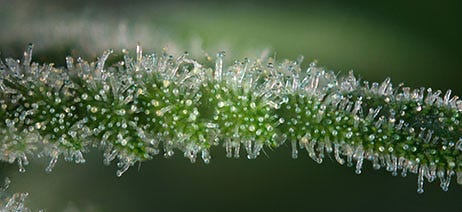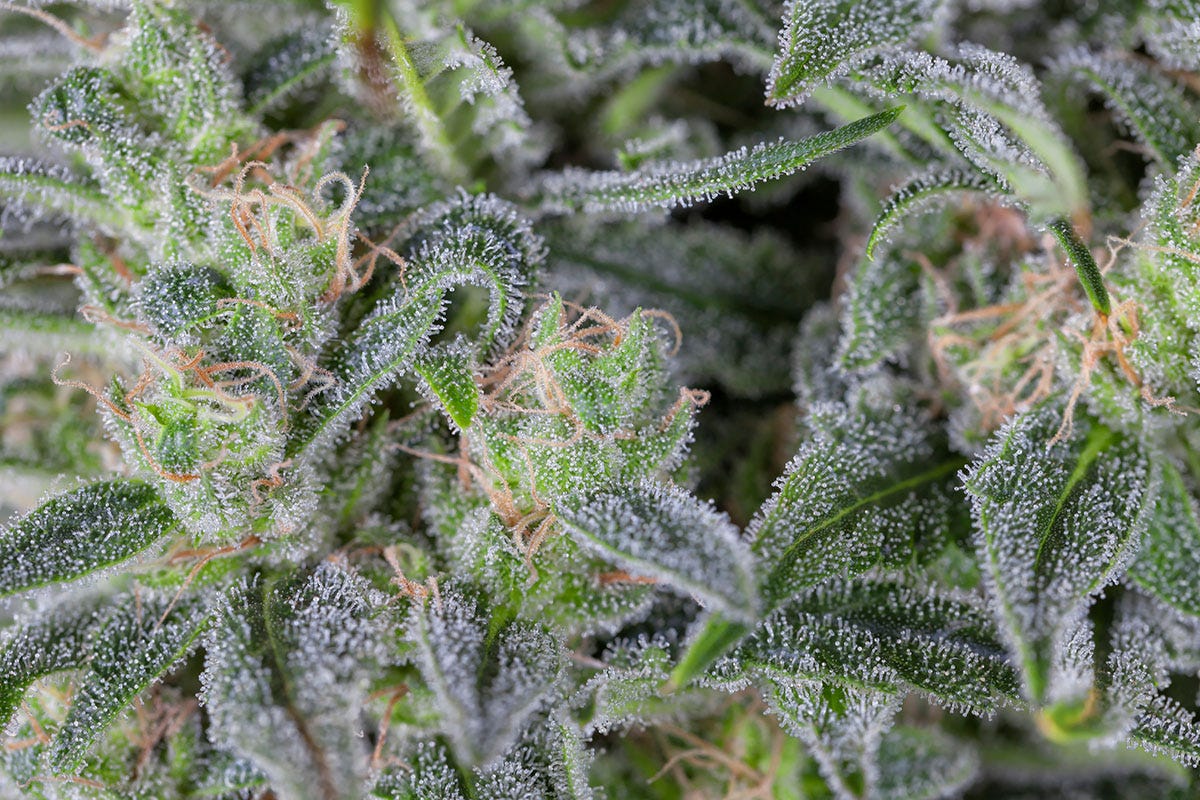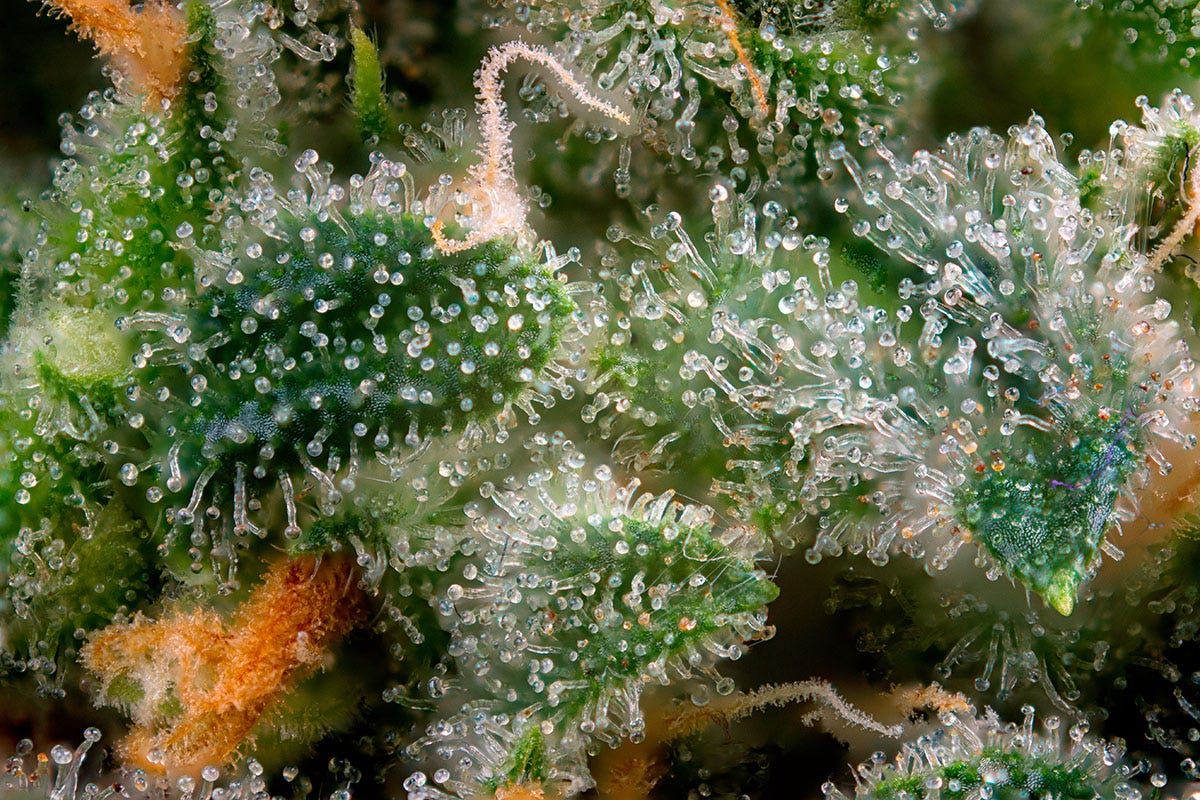
Cannabis Trichomes: What Are They & What Do They Do?
If you’ve seen marijuana flower, chances are, you’ve seen trichomes. You know those little crystals you see on the leaves and flower? You guessed it. Those are trichomes. In this guide, we’ll answer:
- What Are Trichomes?
- Why Does The Plant Need Trichomes?
- Types of Trichomes & What They Do
- Trichomes & Harvesting Cannabis
- FAQs About Trichomes
What Are Cannabis Trichomes?
Cannabis trichomes are resin glands that decorate the surface of marijuana leaves and flower buds.1 They’re sticky and shiny, and they usually have a strong aroma that can be pungent, sweet, woodsy, and more. While they look like little hairs, they’re actually tiny factories that produce all of the incredible cannabinoids, terpenes, and flavonoids that contribute to the entourage effect.2 This effect describes the way that all three of these molecules and compounds work together in the human body and with the endocannabinoid system to produce your experience when you consume marijuana.


Why Does the Plant Need Trichomes?
Plants of all species, including cannabis, have grown in the wild longer than we can even imagine, and a plant that has lived and thrived that long developed a few defense mechanisms along the way–that's where trichomes come in. They create bitter-tasting compounds and an unappealing scent that drives away the insects or animals that might have thought to make the cannabis plant their meal. Trichomes can even create molecules like THC that protect the plant from anything from fungus and UV rays.1 Interestingly, some carnivorous plants use their trichomes to detect prey and, in the case of the Venus fly trap, clamp shut.3
Types of Trichomes & What They Do
Not surprisingly, not all trichomes are the same. First of all, there are two categories of trichomes:4
- Non-Glandular Trichomes: These types of trichomes are typically seen as defense mechanisms in plants, performing tasks like killing small bugs.
- Glandula Trichomes: This is where cannabinoids are produced.


But there isn’t just one type of glandular trichome! They can be divided into three different types:4
Bulbous Trichomes
Don’t go looking for these right away unless you have a microscope. These itty-bitty bulbs are all over the surface of the plant, and they’re the ones responsible for making your marijuana flower a little sticky. While it’s unclear if these do or do not produce cannabinoids, we do know they play an important role in protecting the plant. For example, they help to keep water close to the surface so the plant doesn’t dry out in low humidity or high wind weather.4
Capitate Sessile Trichomes
Another microscope-required trichome, capitate-sessile trichomes have a mushroom shape and they’re much more abundant than bulbous trichomes. But that’s a good thing, because these trichomes actually initiate cannabinoid and terpene biosynthesis.4
Capitate-Stalked Trichomes
If you can see trichomes on your flower, these are the ones you’re looking at. Capitate-stalked trichomes are the only ones viewable with the naked eye, and they look like little mushrooms.4 They’re also the most abundant of the three types of trichomes. This is where the majority of terpene and cannabinoid synthesis occurs.3
Trichomes & Harvesting Cannabis
In addition to the types of trichomes, there are also trichome stages that cannabis producers can use as an indicator of when to harvest certain strains.1 In fact, trichome coloring is one of the best ways to gauge whether or not cannabis flower is ready for harvesting. If trichomes are a milky white color, your flower is ready. If the trichomes are clear, the plant needs a bit more time to develop. (Pro tip: you’ll need a magnifying glass to check!)4


FAQs About Trichomes
Trichomes and the entire topic of cannabis plant anatomy can be confusing! Here are some of the most common trichome questions we see.
Do trichomes have THC?
Yes! In fact, trichomes are where cannabinoids like THC are made in the cannabis plant.
Are trichomes the same as terpenes?
There’s a big difference between trichomes and terpenes: trichomes make terpenes. The reason cannabis trichomes can have such a strong aroma is because the terpenes are actually being made inside these resin glands. In fact, trichomes can be harvested for their terpenes, which are then turned into anything from perfumes and scents for cleaning supplies to candles.4
Are trichomes only found in cannabis?
Nope! While trichomes that produce cannabinoids are exclusive to cannabis, other plants do have trichomes. Research has found them on everything from tomatoes and cucumbers to wormwood, tobacco, and cotton.5
Do male cannabis plants produce trichomes?
Male cannabis plants can have trichomes, but in much smaller amounts than a female cannabis plant. This is because the male plant doesn’t produce the cannabis flower, the part that is chock full of trichomes.6


More About Trichomes
Trichomes play an important role in many plants, including cannabis, and continue to be studied to better understand both how they work and the potential qualities of the compounds inside of them. Learn more about trichomes at your local dispensary.
Sources:
1. “What are trichomes and why do they exist on cannabis?,” Leafly, March 7, 2024, https://www.leafly.com/news/science-tech/what-are-trichomes-on-cannabis
2. “Cannabis Glandular Trichomes: A Cellular Metabolite Factory,” Frontiers in Plant Science, September 20, 2021, https://pmc.ncbi.nlm.nih.gov/articles/PMC8488169/
3. “Trichomes as sensors,” Plant Signaling & Behavior, January 5, 2010, https://pmc.ncbi.nlm.nih.gov/articles/PMC2835965/
4. “What are trichomes?,” Weedmaps, https://weedmaps.com/learn/dictionary/trichome
5. “Glandular trichomes: new focus on horticultural crops,” Horticulture Research, July 1, 2021, https://www.nature.com/articles/s41438-021-00592-1
6. “What Are Trichomes and What Do They Do?,” Leafwell, May 23, 2025, https://leafwell.com/blog/trichomes


